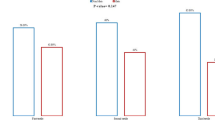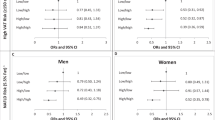Abstract
Purpose
Given the current prevalence of obesity, it is important to identify dietary factors that may aid in disease prevention. The objective of the present study was to evaluate the association between consumption of an energy-dense diet and established markers factors for chronic disease, including body weight and measures of body fatness.
Methods
Data from a nationally representative sample of 9,551 adults ≥18 years who participated in the 2005–2008 National Health and Nutrition Examination Survey were analyzed. The association between dietary energy density (ED, energy per weight of food, kcal/g) and markers for obesity [including body mass index (BMI) and waist circumference (WC)], insulin insensitivity [including fasting glucose, insulin and homeostasis assessment model for insulin resistance (HOMA-IR)], and markers for inflammation was examined.
Results
Dietary ED was positively associated with obesity in both men and women in multivariate models. Overall, obese adults had a significantly higher dietary ED than lean adults (p < 0.0001). Current smokers had significantly higher ED than non-smokers (2.00 vs. 1.75, p < 0.01), and it was determined that smoking status modified the relationship between ED and weight status in women (p interaction 0.03). In both sexes, there was a positive linear relationship between BMI and ED (p trend 0.01 and 0.0002, respectively); a linear trend between WC and ED was also observed in women (p trend <0.001) after adjusting for relevant cofactors. In women, ED was positively associated with HOMA-IR and fasting insulin; though, this relationship was not observed in men. No significant associations between ED and C-reactive protein were observed in either sex.
Conclusion
These findings support recent obesity and disease prevention recommendations to consume a diet low in ED.


Similar content being viewed by others
References
DiFranza JR, Wellman RJ (2005) A sensitization-homeostasis model of nicotine craving, withdrawal, and tolerance: integrating the clinical and basic science literature. Nicotine Tob Res 7(1):9–26. doi:10.1080/14622200412331328538
Marmot M (2007) Food, nutrition, physical activity, and the prevention of cancer: a global perspective. World Cancer Research Fund/American Institute for Cancer Research, Washington
Rolls BJ (2009) The relationship between dietary energy density and energy intake. Physiol Behav 97(5):609–615. doi:10.1016/j.physbeh.2009.03.011
Mendoza JA, Drewnowski A, Christakis DA (2007) Dietary energy density is associated with obesity and the metabolic syndrome in U.S. adults. Diabet Care 30(4):974–979. doi:10.2337/dc06-2188
Ledikwe JH, Blanck HM, Kettel Khan L, Serdula MK, Seymour JD, Tohill BC, Rolls BJ (2006) Dietary energy density is associated with energy intake and weight status in US adults. Am J Clin Nutr 83(6):1362–1368
Kant AK, Graubard BI (2005) Energy density of diets reported by American adults: association with food group intake, nutrient intake, and body weight. Int J Obes (Lond) 29(8):950–956. doi:10.1038/sj.ijo.0802980
Stookey JD (2001) Energy density, energy intake and weight status in a large free-living sample of Chinese adults: exploring the underlying roles of fat, protein, carbohydrate, fiber and water intakes. Eur J Clin Nutr 55(5):349–359. doi:10.1038/sj.ejcn.1601163
Howarth NC, Murphy SP, Wilkens LR, Hankin JH, Kolonel LN (2006) Dietary energy density is associated with overweight status among 5 ethnic groups in the multiethnic cohort study. J Nutr 136(8):2243–2248
Hartman TJ, Albert PS, Zhang Z, Bagshaw D, Kris-Etherton PM, Ulbrecht J, Miller CK, Bobe G, Colburn NH, Lanza E (2010) Consumption of a legume-enriched, low-glycemic index diet is associated with biomarkers of insulin resistance and inflammation among men at risk for colorectal cancer. J Nutr 140(1):60–67. doi:10.3945/jn.109.114249
Monzillo LU, Hamdy O (2003) Evaluation of insulin sensitivity in clinical practice and in research settings. Nutr Rev 61(12):397–412
U.S. Department of Agriculture ARS, Beltsville Human Nutrition Research Center, Food Surveys Research Group (Beltsville, MD) and U.S. Department of Health and Human Services, Centers for Disease Control and Prevention, National Center for Health Statistics (Hyattsville, MD). (2010) What We Eat in America, NHANES 2005-2008. U.S. Department of Agriculture. http://www.ars.usda.gov/Services/docs.htm?docid=18354. Accessed 1 April 2011
Flegal KM, Carroll MD, Ogden CL, Curtin LR (2010) Prevalence and trends in obesity among US adults, 1999-2008. JAMA 303(3):235–241. doi:10.1001/jama.2009.2014
Vernarelli JA, Mitchell DC, Rolls BJ, Hartman TJ (2013) Methods for calculating dietary energy density in a nationally representative sample. Procedia Food Sci 2:68–74. doi:10.1016/j.profoo.2013.04.011
Ledikwe JH, Blanck HM, Khan LK, Serdula MK, Seymour JD, Tohill BC, Rolls BJ (2005) Dietary energy density determined by eight calculation methods in a nationally representative United States population. J Nutr 135(2):273–278
Vernarelli JA, Mitchell DC, Hartman TJ, Rolls BJ (2011) Dietary energy density is associated with body weight status and vegetable intake in U.S. Children. J Nutr 141(12):2204–2210. doi:10.3945/jn.111.146092
Johnson L, Wilks DC, Lindroos AK, Jebb SA (2009) Reflections from a systematic review of dietary energy density and weight gain: is the inclusion of drinks valid? Obes Rev 10(6):681–692. doi:10.1111/j.1467-789X.2009.00580.x
Ledikwe JH, Blanck HM, Khan LK, Serdula MK, Seymour JD, Tohill BC, Rolls BJ (2006) Low-energy-density diets are associated with high diet quality in adults in the United States. J Am Diet Assoc 106(8):1172–1180. doi:10.1016/j.jada.2006.05.013
Schroder H, Marrugat J, Elosua R, Covas MI (2002) Tobacco and alcohol consumption: impact on other cardiovascular and cancer risk factors in a southern European Mediterranean population. Br J Nutr 88(3):273–281. doi:10.1079/BJN2002655
Miller PE, Lesko SM, Muscat JE, Lazarus P, Hartman TJ (2010) Dietary patterns and colorectal adenoma and cancer risk: a review of the epidemiological evidence. Nutr Cancer 62(4):413–424. doi:10.1080/01635580903407114
Perez-Escamilla R, Obbagy JE, Altman JM, Essery EV, McGrane MM, Wong YP, Spahn JM, Williams CL (2012) Dietary energy density and body weight in adults and children: a systematic review. J Acad Nutr Diet 112(5):671–684. doi:10.1016/j.jand.2012.01.020
Acknowledgments
This study was supported in part by a Grant from American Institute of Cancer Research (10A078). We acknowledge the assistance provided by the Population Research Center at The Pennsylvania State University, which is supported by an infrastructure grant by the National Institutes of Health (2R24HD041025-11).
Author information
Authors and Affiliations
Corresponding author
Rights and permissions
About this article
Cite this article
Vernarelli, J.A., Mitchell, D.C., Rolls, B.J. et al. Dietary energy density is associated with obesity and other biomarkers of chronic disease in US adults. Eur J Nutr 54, 59–65 (2015). https://doi.org/10.1007/s00394-014-0685-0
Received:
Accepted:
Published:
Issue Date:
DOI: https://doi.org/10.1007/s00394-014-0685-0




